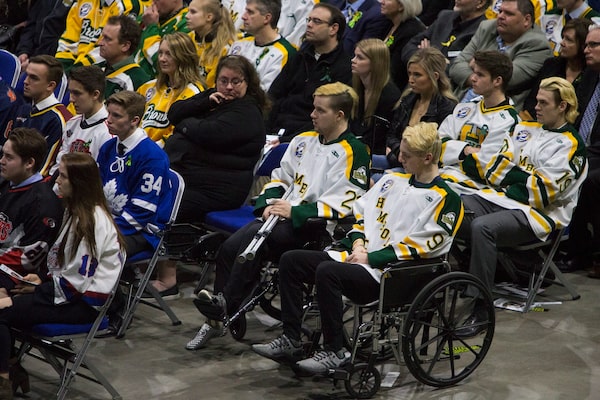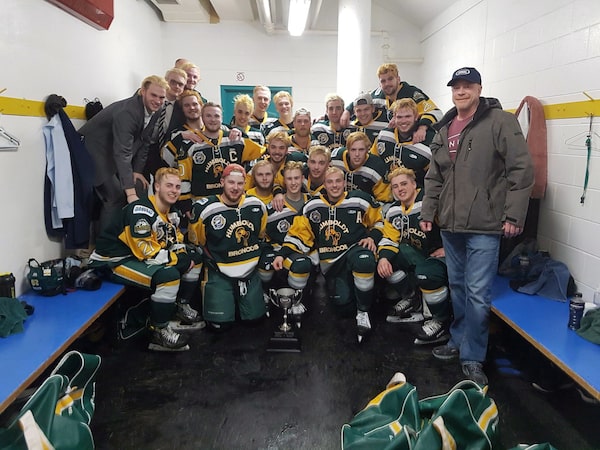Crosses and other memorabilia dot a makeshift memorial where the Humboldt Broncos bus collided with a semi-trailer last April near Nipawin, Sask.Kayle Neis/The Globe and Mail
For Canadians, the tragedy that struck the Humboldt Broncos has no peer. It is still shocking nearly nine months later.
Many of us have daughters and sons who play hockey. Many more have placed children on buses for other activities. The idea that something terrible could happen was not even a thought.
That naïveté ended with the April 6 crash in Saskatchewan. Ten players on the Junior-A level team were among the victims, along with the bus driver, two coaches, the athletic trainer, a broadcaster and a statistician.
The players were between the ages of 16 and 21, and handsome boys like our own. They were robust young men with so many hopes and dreams. They were family members and heroes in their community.
They were loved.
My son was 19 and attending college in Boston when the accident occurred. A chill came over me when I heard. He has played hockey since he was 5. He has ridden buses to games.

Survivors Graysen Cameron, in wheelchair, and Derek Patter, holding crutches, at the funeral of Broncos player Evan Thomas in Saskatoon.Kayle Neis/The Canadian Press
After arriving in Humboldt the next day, I saw his face in each of those boys. Their hair was died blonde for the playoffs, just as his was when he was 12 and his peewee team went to the New Brunswick provincial championships.
I saw myself in every one of the heartbroken parents, too. All of us did. It was something random, and could happen to anyone.
Families wept at their tables at Johnny’s Bistro, the restaurant in Humboldt where Broncos players eat eggs benedict for breakfast on game days. Parents sobbed in hotel hallways as they made funeral arrangements.
Some had been charged with the unimaginable task of identifying a dead child. To be certain, one father wiped dried blood off his son’s face to reveal his birthmark.
For a journalist, to arrive in a place in the wake of a disaster is not easy. No matter how many times you have done it, it is impossible not to feel terribly intrusive.
There is a desire to satisfy the public’s interest and a need to be respectful. It is difficult not to become emotional.

The Boulet family – Toby, wife Bernadine and sister Mariko – watch as pallbearers carry the casket of their son and brother, Logan Boulet, in Lethbridge, Alta.David Rossiter/The Canadian Press
A decade ago, I wrote about the deaths of seven members of the basketball team at Bathurst High School. They died when the van in which they were riding slid on a slippery highway in New Brunswick and into the path of a semi-trailer.
It is one thing when tragedy strikes in a big city and another when it happens in a small community such as Bathurst or Humboldt. When something happens in a small place, shock waves seem to travel even farther.
Consolation messages were received from the Royal Family and hockey royalty. The prime minister attended a vigil along with his hockey-playing son, Xavier, then 10 years old. Don Cherry and Ron MacLean came, too.
It was an example of how sports connects us all, and it cast an uncomfortable spotlight on a team and a Saskatchewan prairie town that most had never even heard of. Nobody wants to be famous for misfortune.
In Humboldt, nearly a third of the 5,700 residents turn out for some Broncos games. Players shovel driveways and deliver lunches to school. They are taken in as billets by families and are treated like one of their own.
There is a personal connection there that is unlike anything in professional sports.
Despite their sorrow, people in Humboldt showed remarkable grace under the most traumatic circumstances imaginable. They shared their emotional vulnerability with us, and we loved them for it.
It was most likely the biggest news story of the year in Canada. It shook everyone to the core.

Sixteen players and staff were killed and 13 players were hurt when the Broncos bus crashed on the way to a playoff game in April.HO/The Canadian Press
Families will mourn the loved ones who were lost. Humboldt will heal, but it will be a slow and difficult process. It is not something a community can collectively forget.
There is a tribute to the Broncos on the second floor of an art gallery downtown. It is a revolving exhibit because there is not enough display space to show everything at once.
Items sent to Humboldt from all over the world fill two vaults downstairs. The building that houses the gallery used to be a bank.
There are cards upstairs from a second-grade class in Tuktoyaktuk, NWT. There are 1,000 origami birds fashioned by school students in Regina. There is a Canadian flag knitted by a 90-year-old woman in Swan River, Man. She had a stroke a week after the accident that left her nearly blind, but she did it anyway. She felt an overwhelming need to express sympathy to strangers.
Countless people have sent messages, and others have made pilgrimages to Humboldt from all over North America. One fellow rode a bicycle 1,575 kilometres from Denver this summer, simply because he wanted to see it. Jayson Miller, who oversees a street ministry in Edmonton, came several weeks ago, carrying a banner with messages of love scrawled all over it.
Before taking it to Humboldt, he had taken it to Nunavut after a rash of suicides and to the synagogue in Pittsburgh that was the site of a hate crime.
The driver of the Broncos bus took a different route than usual to the game in Nipawin that day. It added a few minutes to the travel time, and caused the bus to arrive at the intersection where the crash occurred from a different direction than normal.
It is just by chance that the Broncos were there. On the bus, players were probably listening to music through their ear buds, like so many of our daughters and sons. The accident took a little bit of each of us with them.
This year’s team is near the top of the standings, despite only having two returning players. There is no escaping why there are so many newcomers: the names of the boys they replaced are engraved in the seats in front of their dressing stalls.
Nathan Oystrick, the head coach and general manager of the Broncos, stepped down on Friday. But fans are cheering at their games. In Humboldt, it is possible to love again, and never forget.
 Marty Klinkenberg
Marty Klinkenberg